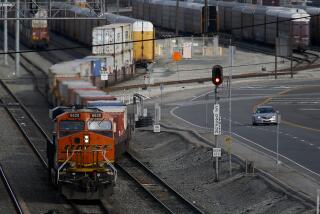AQMD Moves Its Ride-Sharing Rule to the Back Seat : Smog: Air Quality board creates a new task force to find new ways to reduce solo commuting.
Moving toward overhauling one of its most far-reaching and unpopular efforts to combat smog, the Southlandâs air quality board on Friday formed a task force to search for new ways to remove solo commuters from the regionâs roads.
The decision by the South Coast Air Quality Management District board was applauded by many businesses that have complained for years that they have unfairly had to shoulder the burden of trying to revolutionize the way Southern Californians commute.
In addition to forming the task force, the board voted to allow businesses to delay implementing new ride-sharing incentives as long as they still meet their current goals. The agencyâs enforcement staff also was directed to issue warning notices--instead of imposing fines--when businesses do not fulfill ride-sharing requirements, unless the violations are âclearly flagrant.â
Under the AQMDâs ride-share rule adopted six years ago, companies in Los Angeles, Orange, Riverside and San Bernardino counties with more than 100 employees must establish programs that encourage employees to car-pool, take mass transit or use other means of getting to work.
Covering 5,200 companies with 1.3 million employees, the groundbreaking rule has been one of the AQMDâs most ambitious efforts to fight smog. Its goal is to increase rush-hour ridership to an average of 1.5 people per car. To comply, companies must subsidize train and bus tickets for employees, form van pools and offer free parking or other incentives to car-poolers.
The rule has been unpopular because thousands of offices and other non-industrial businesses must spend large amounts of money to create elaborate ride-share plans. Collectively, employers in the four-county area spend about $160 million a year on the programs, according to one recent study done for the AQMD.
The AQMDâs effort to revamp its program will be monitored nationally because dozens of other smoggy cities have begun to model ride-sharing regulations on Southern Californiaâs.
AQMD Board Chairman Henry W. Wedaa, who spearheaded the effort to review the regulation, said the new task force will face the challenge of coming up with less costly and onerous ways to persuade commuters to leave their cars at home.
Members of the task force will be appointed by the AQMD board. Its size and makeup has yet to be determined.
But a number of ideas for revamping the program have surfaced. Among them is setting auto registration fees according to the number of miles driven, or charging motorists for driving during peak traffic hours. Such efforts, however, would require new state laws.
Wedaa stressed that the AQMD cannot abandon or weaken the program because state and federal laws require the agency to remove a large number of cars from Southland roads by the end of the decade.
âWe are not scaling it back. I am not a supporter of that,â said Wedaa, a Yorba Linda city councilman. âBut I am a supporter of supplying more options to obtain the same goals.â
Before voting unanimously for the task force, several board members advocated rescinding the ride-share regulation completely. Its strongest critic on the board is Los Angeles County Supervisor Michael Antonovich, who called it an excessive case of âBig Brotherâ government imposing its will on private businesses.
Other board members, however, hailed the regulation as an efficient and relatively inexpensive way to reduce smog.
âWhat are we going to substitute instead? What is the cost to society . . . if we scrap this program entirely?â asked AQMD board member and Los Angeles City Councilman Marvin Braude.
Although AQMD staff members acknowledge that the ride-share rule is unwieldy and time-consuming for businesses, they say it has been one of the most effective methods of reducing smog-causing emissions.
The average number of riders per car has increased to 1.24 from 1.13 when the program was adopted in 1987, according to the AQMD. During that time, the agency estimates that 11 million one-way trips per year have been eliminated in the four counties.
But critics among business leaders and government officials have condemned it as a costly attempt at social engineering that is bound to fail because so many Southland residents depend on their cars.
More to Read
Sign up for Essential California
The most important California stories and recommendations in your inbox every morning.
You may occasionally receive promotional content from the Los Angeles Times.










